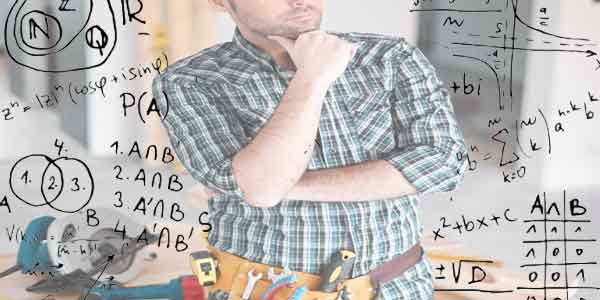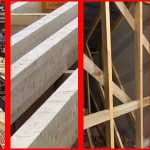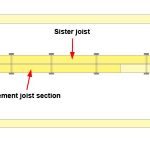In this article, we will be looking at whether carpenters need to be good at math. This will include, looking at situations where working things out require some mathematical ability.
In general, carpenters do need to be good at math. They are constantly measuring and cutting wood, as well as ordering materials for large jobs, which needs working out correctly. If measurements are not worked out properly, this can result in waste, or even a shortage of materials.

On a daily basis, carpenters are adding, subtracting, multiplying, and dividing. There are also certain situations, where more complex math can be helpful. This can include things like Pythagoras theorem and trigonometry.
General arithmetic is what you will be using most of the time. However, knowing some more complex math can certainly be helpful.
Working out materials
One of the most common uses for maths in carpentry, is working out materials. This is necessary on any job where a large number of materials is needed. This could include:
- Skirting and architrave
- Studwork timber
- Decking timber (frame and boards)
- Floorboards and other types of flooring
- Installing sheet materials such as ply, MDF, OSB,
- Roof timbers
- Etc.
These are just a few examples, but you get the point. Below you can see a few more detailed examples, of how this might look in practice.
Example #1 – Measuring up for skirting boards
If you are ordering something like skirting boards, you will need to measure the length of walls it is being installed on. You may also consider the length of the boards and how they are cut to avoid waste.
Bits of skirting off-cut, will often fit in other areas, which can avoid cutting another full length. Taking a small amount of time to consider this, will ensure you maximise the skirting boards used, and avoid waste. This can save you a decent amount of money, especially on private jobs, where waste can eat into profit.
Another thing you may need to work out, is the number of fixings required over a large area.
Example #2 – Measuring for sheet material, flooring, or decking
When you are installing any kind of boards, or sheets over a large area, the area itself will need working out. In a relatively square, or rectangular space, this can be done by multiplying the length of the area by the width.
This area can then be divided by the size of the sheets or boards, to give you the rough number of material units needed.
Again, you should always take off-cuts into consideration. This will tell you:
- How much of the waste is usable
- Whether you need to round up
- And if you need additional materials, to account for unusable waste.
Example #3 Ordering timber for studwork
As with any job, the complexity of measuring for materials, will depend on the scale of the work.
If you are building one small wall, then working out materials should be quite easy. However, a large job, such as studwork for an entire house, could be more challenging.
You will need to consider the length of all the top and bottom plates. You will then need to consider the studs. How many you need, will be determined by the spacing. This should include any overlaps, and areas where double studs are required to carry plasterboards.
Following this, you will also need to account for noggins between the studs. In many cases, you will have offcuts that can be used for the noggins. Or you may need to order additional timber.
All of this will need working out based on the size of timber you will be using.
Common lengths include:
- 2.4m
- 3m
- 3.6m
- 4.8m
You may find that a certain length is far better at creating usable waste for things like noggins.
You will also need to work out sizes for door openings, in order to fit your door casings.
Finally, you may need to work out for materials to finish the studwork. This could include things like insulation and plasterboard. The amount of these materials needed, will usually be based on area. As always, measuring everything correctly will reduce waste.
As you can see, the main theme here, is ordering the correct number of materials and avoiding waste.
Some other ways carpenters use math
- creating right angles – This is quite simple and can be done using something called the 3-4-5 method. You can see a good example of this being used in the video below.
- Working out other angles – This can be done in many different ways and in certain instances, more complex maths can come in handy. Other times, you can use simple tools, like a sliding bevel or a tape measure to find angles.
- Measuring and designing layouts – This could be for things like kitchen units, fitted furniture, and anything else where space needs to be maximised.
- Working out staircase size – Maths is required, to create a staircase with the correct number of steps, these need to be level, and have an appropriate pitch that meets building regs (42° maximum). This should be accompanied with a rise on each step of between 150-220mm, as well as a going of 220-340mm. This will all require math to work it out correctly.
- Working from technical drawings – Obviously technical drawings are scaled down. This means a carpenter needs to scale up measurements from the drawing, in order to fit things as directed by the architect.
- General day to day measurements – A carpenter’s work should be mm perfect. Especially when it comes to second fix and finishing work. This means you are constantly using a tape measure and other tools to make sure measurements are 100% accurate.
Conclusion
Carpenters do need to be good at math. It is a skill they will use on a daily basis. The level of math skills they will need, will depend on the type of work they are doing. As well as being good at mathematics, they will also benefit from critical thinking and problem-solving abilities. Every job is different, and this means a skilled carpenter can adapt to make things work correctly. This can involve adjusting measurements and processes to make things fit.




